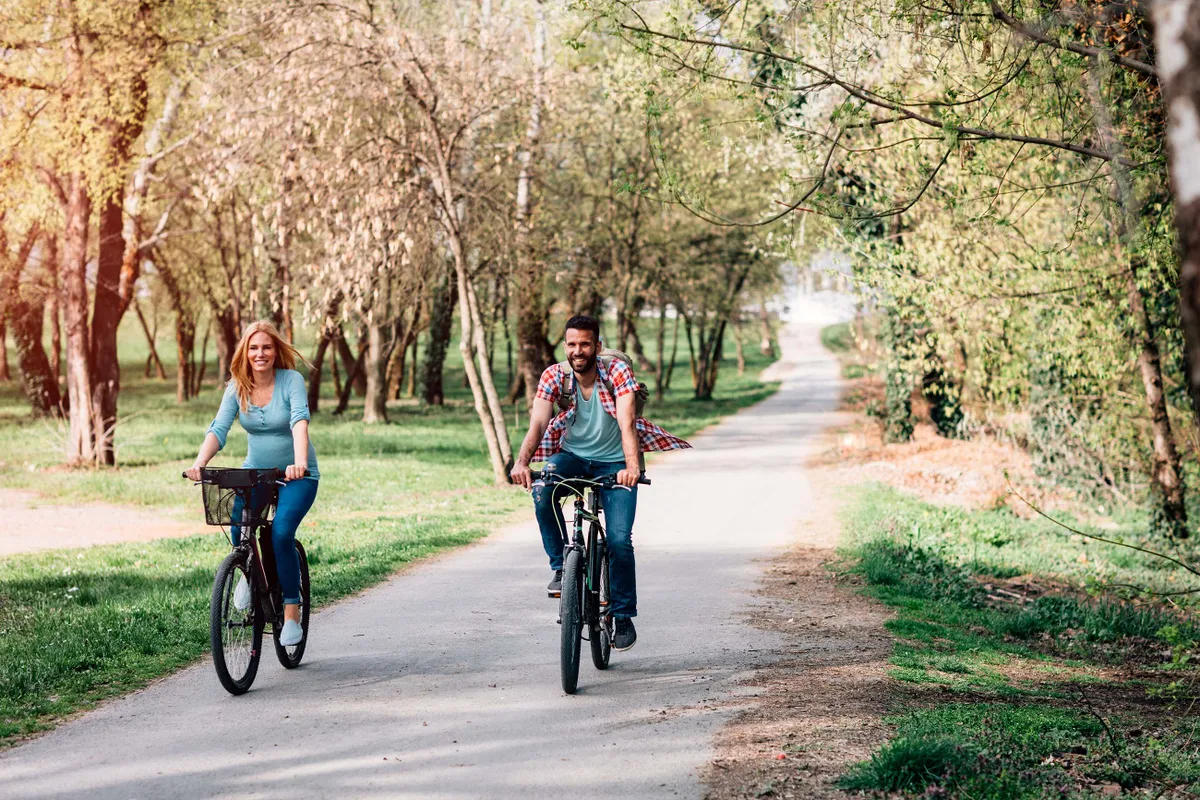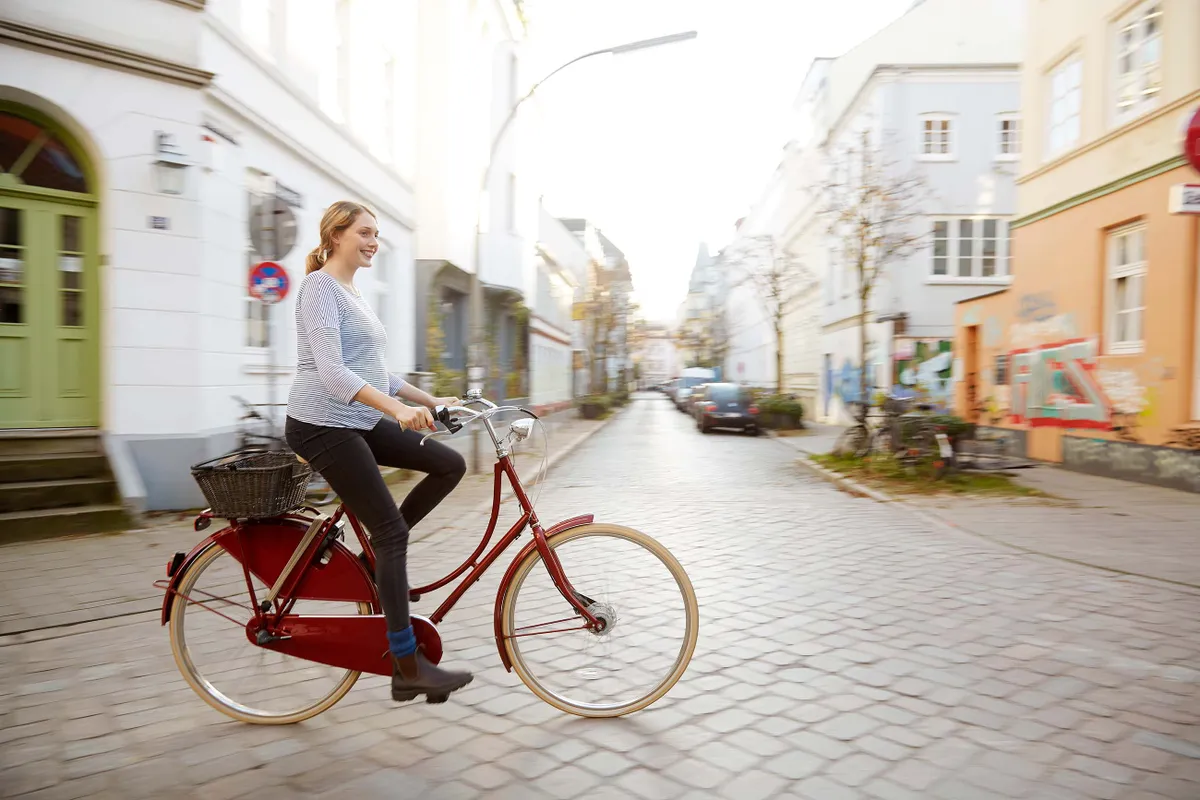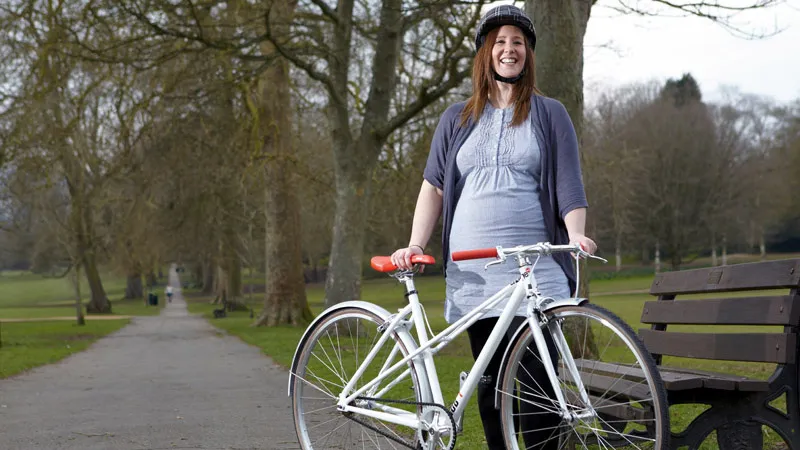World champion track and road cyclist Lizzie Deignan announced in February that she is pregnant with her second child.
Having continued to cycle until three days before the birth of her first child – daughter Orla, born in September 2018 – she returned to racing seven months later and won the OVO Energy Women’s Tour of Britain just nine months after giving birth.
Deignan hopes her return to the Trek–Segafredo team will be just as speedy this time, but how can women continue to enjoy cycling safely during pregnancy, and how quickly should mere mortals expect to get back on the bike after giving birth?
Sheffield-based GP Dr Andy Douglas, whose wife Rebecca Douglas continued cycling during her pregnancy in 2021 – including cycling to her scans – says there is a lack of advice around exercise, and specifically cycling, during pregnancy.
“I have knowledge and training in it from my job as a GP, but otherwise the information from most sources, such as midwives, GPs and pregnancy booklets, is fairly limited,” he admits.
Indeed, the NHS website offers a page of generic ‘Exercise in pregnancy’ advice, including “Keep up your normal exercise for as long as you feel comfortable” and “Exercises that have a risk of falling, such as horse riding, downhill skiing, ice hockey, gymnastics and cycling, should only be done with caution. Falls carry a risk of damage to your baby.”
As for intensity? “Do not exhaust yourself” and “As a general rule, you should be able to hold a conversation as you exercise when pregnant”. The NHS advises consulting your maternity team if in doubt.
Dr Douglas says cycling role models and athletes such as Sarah Storey, Deignan and Laura Kenny were a helpful source of advice and support for Rebecca through social media.
“It was inclusive from the elite athlete perspective through to beginner cyclists,” says Dr Douglas.
“A lot of it was evidence-based advice for exercise in pregnancy, such as Jessica Ennis-Hill’s blog and the Bump it Up book by Professor Greg Whyte.”
Benefits of exercising while pregnant

The benefits of exercising while pregnant are, of course, many. The National Childbirth Trust (NCT) website currently lists numerous advantages, from helping to reduce high blood pressure and lowering the risk of pre-eclampsia (a pregnancy complication) to shortening the length of labour and improving the likelihood of a straightforward labour and recovery.
Kelly Clark, head of National Cycle Network in London at Sustrans, was commuting around 60 miles a week by bike before her first pregnancy, as well as longer half-day or full-day road or mountain bike rides. She says official advice usually encourages only gentle exercise, and it can be disquieting.
“It urges caution and is packed with disclaimers that make it easy to think that the most normal things are an unnecessary risk,” says Clark.
“It isn’t much use if you are already an active person, skilled at a particular sport, or used to training and racing, and can be alarming and discouraging.” She adds that this can put many women off, and many don’t return to cycling after a long break and a big life change.
As Dr Douglas says: “For a regular cyclist who becomes pregnant, I would encourage her to keep cycling, and work with her to come up with an individualised plan about how best to continue.”
He adds that for some people, the perceived risk of injury, from falling off or being hit by a car, can be a big concern.
“For my wife this meant choosing routes that she felt more comfortable on, riding with people she knew well, and avoiding trickier conditions such as icy roads.”
Dr Douglas says that, from his time working in maternity wards as a junior doctor, he learnt how well protected babies are: “In reality, we probably overestimate the risk,” he concludes.

Deignan says specific athlete-related advice was hard to find during her first pregnancy, so she just trusted her own instinct. Like many women, she found cycling more comfortable than walking.
It also moved the uncomfortable fluid build-up around. Deignan continued cycling the same routes during pregnancy, just slower.
“There were definitely days when I turned around after five minutes because I felt too fatigued or it wasn’t right, but every day was different,” she says.
Indeed, every pregnancy, and every woman, is different. As Deignan says: “With my daughter, I had nausea for the first 12 weeks and this time round I’ve had nausea for 18 weeks and I have been much more tired and less able to ride my bike. I have learnt that baby is in charge, and I have to respect what my pregnancy is telling me.
"It isn’t useful to compare because every pregnancy and every mother is different.”
These differences extend to comfort on the bike. Deignan says she uses the same bike but has raised the handlebars and tilted the stem to accommodate her changing shape.
Others change to a new bike, such as keen road cyclist Rhiannon Hedge, who lives in Cardiff. Hedge cycled until she was seven months pregnant, but switched bikes after five months.
“I wasn’t comfortable on a road bike due to my bump and the strain on my lower back. In my first pregnancy, I switched to a Brompton for a more upright position.”
Now, at 33 weeks pregnant with her second child, she is riding a Dutch-style bike. “It’s still very comfortable,” she says.
Cycling after pregnancy

The perceived risk of injury to which Dr Douglas alludes can also be a common concern. Hedge says she stopped cycling at seven months because she felt too unsafe to continue her usual commute along busy roads with little cycling infrastructure.
“When you’re going much slower than you're used to and you can’t react quickly to dangerous driving it can be intimidating.”
New segregated cycleways have since been built in Cardiff, Wales, transforming Hedge’s experience.
She has also seen a difference in people’s reaction. “If you’re cycling through a park or on a designated cycleway, people smile at you indulgently. If you’re on a road sharing space with cars, people often react negatively.”
Deignan says she has experienced mixed reactions to cycling when pregnant, but acknowledges she may once have been surprised to see a heavily pregnant woman cycling.
“It’s different when you’re in that situation. It’s about each mother assessing what they think is a risk and what they also need for their own mental health.”
She adds that she’s grumpy if she doesn’t exercise regularly. “I rely on being outside as well as the exercise itself to be happy and relaxed.”
Hence Deignan’s desire to return to racing six months after the birth of her second child.
“I’d love to be able to breastfeed my baby again. I was able to do that for six months with my daughter and that is my aim this time. Every baby is different and it might not work out, but that was the limiting factor in me not being able to race.”

How quickly any woman can return to cycling after giving birth will also depend on the delivery and any labour complications, for which it is advisable to get advice from the maternity team or GP.
As Dr Douglas says, “After my wife had a caesarean (C-Section) she was back on the turbo having a tentative try after six weeks, then gentle off-road routes after another week or two.
"During the time after delivery, especially after a C-section, there is a much higher risk of blood clots, so it is especially important to start moving about ASAP.”
A return to cycling may also demand another bike adjustment, or a change of riding style. As Clark says: “After birth, I found it took a good few weeks before I was comfortable sitting on a bike saddle again – I had to ride BMX-style for a while to avoid sitting down.”
Clark, like many other active women, has worked out a way of cycling before and after the birth of a child that works for her, pieced together from several sources of advice, plus her own situation and biking experience.
It seems that precisely because everyone is unique, it’s almost impossible to give blanket advice. It’s time to listen to your body, your instinct and your maternity team and work out within your limits.
Cycling during pregnancy Q&A

Dr Teresa Kelly, a consultant obstetrician and spokesperson for the Royal College of Obstetricians and Gynaecologists, provides advice on cycling while pregnant and Radka Kahlefeldt, professional triathlete for Liv Racing Collective, speaks of her own experience cycling when pregnant.
Dr Teresa Kelly
What guidance would you offer to pregnant women who want to continue cycling?
It’s important to stay active and eat well during pregnancy. Maintaining a good level of exercise and physical activity that is usual for you can help the body adapt to the changes brought on by pregnancy.
Pregnant women should only do what they feel comfortable with and listen to their bodies.
While someone who was a keen cyclist before pregnancy may find it comfortable to continue, we would advise caution for pregnant women who did not cycle regularly before.
Should pregnant women change their bike or riding position?
They may find it more comfortable to sit more upright on a bike, especially later in their pregnancy.
If cycling is still uncomfortable after adjusting the position, we would advise pregnant women to be cautious, and not to put unnecessary strain on their bodies.
Exercise during pregnancy does not have to be strenuous to be beneficial.
It is completely normal to ease the intensity of exercise as pregnancy progresses. It is important to adjust to what feels comfortable during pregnancy, and only continue for as long as it feels comfortable.
How soon can women safely return to cycling after having a baby?
It is important that women listen to their bodies, and do not undertake any exercise which may lead to discomfort or excessive breathlessness.
They should discuss any concerns about returning to exercise at the six-week postnatal check.
Radka Kahlefeldt

How quickly did you return to cycling after giving birth?
I have two little girls and both deliveries were different. After my first delivery, I had to be more patient as it took me a week to be able to sit down on a chair.
But once I could comfortably sit, I started riding. I used a turbo trainer to begin with – I wanted to be close to my baby and I just felt more comfortable at home.
With my second child, Indiana, the delivery was a little bit smoother and I was able to ‘jump’ on my road bike three days later.
I went straight on the road, mainly to just get out of the house and get some downtime for myself. I rode for only one hour, but it was a great feeling.
My first baby, Ruby, was a really good baby so I was able to get back into some serious riding pretty soon.
I was doing most of my rides on a wind trainer. I got back into good shape and I won my first race (the Ironman 70.3 Davao in the Philippines) back when Ruby was 11 weeks old.
Did you experience any stigma when cycling in later pregnancy?
People are a little bit sceptical when they see a heavily pregnant woman exercising. But we now know that if you’re used to exercising, then you should just keep doing it.
I stopped riding outdoors from 24 weeks with my first baby as the doctor recommended that to me, but I kept riding on the turbo. It was for safety reasons.
But during my second pregnancy, I was riding on the road much longer as I felt comfortable with that. I just wasn’t riding in a bunch, to avoid any crashes.
What would your advice be to other women who want to continue cycling when pregnant?
Stay active, listen to your body and remember that exercising is great for you and your baby. Also, the blood flow will help with any nausea and stress.
Cycling in the different trimesters of pregnancy
First trimester
The first 12 weeks are a crucial time for the foetus to grab a firm hold inside the womb, and this period has the highest risk of miscarriage.
Keep cycling, but do it gently and only if you feel like it — fatigue and morning sickness, which can last all day and all night, might force you to stop for a while.
Listen to your body. Cycling off-road is not recommended, it comes with too many jolts and bumps, and a high chance of being sent over the bar.
Second trimester
During months three to six, the chances of miscarrying fall dramatically. The tiredness and nausea of the first trimester are likely to have eased too, meaning you might have more energy than before.
Cycling at this stage will keep you fit and supple, which should help you cope with any aches or pains from carrying extra weight. Just remember to remain cautious despite your newfound energy, because a tumble won’t be good for mother or baby.
Third trimester
From month six to your due date, your bump will be big and active. You might get short of breath, especially on the hills, and leaning over the handlebar can be challenging.
Dutch-style bikes have a position that avoids leaning over on your stomach. Many pregnant women are plagued by haemorrhoids, so a wide saddle with a gel seat cover might be required.
If you feel unstable with the bump, it’s time to put your bike to one side, but this is a personal choice. Cycling keeps you fit and pliable, and gives you stamina for the labour itself.
